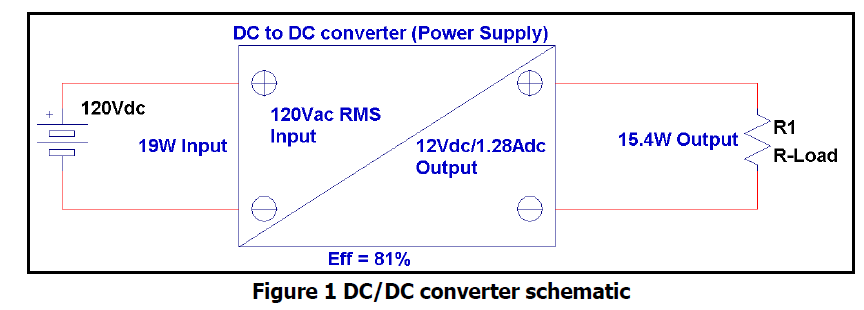In this article we will explain the efficiency of DC systems and progress to AC systems on the next article. In very basic terms, efficiency is the measure of how much power is not being wasted by a system. More waste is less efficient. In electrical systems, we measure the power entering a system in watts; the unit of measure for work performed. Efficiency is the ratio of (Power-In) -vs. - (Power-Out) as a percentage. Sometimes the work coming out of a system needs to be converted from some other unit of work back into watts so when the efficiency is examined, the equation can be evaluated in like terms. Efficiency is commonly abbreviated (Eff) or (EF%) or simply (η). Efficiency is paramount.
A single Watt of energy is delivered to the load when 1amp (RMS or DC) of current is passing through a 1ohmload for 1second. DC systems don’t have Power Factor to complicate the situation. [1]
In Direct Current (DC) systems: Watts(W) = Adc ×Vdc [1]


Had a converter been installed with 40%EFF, the input current required to drive the same load would be twice as much, and the heat to dissipate due to inefficiency would also be worse!
Only DC systems like this get to enjoy such simple math to describe the input power in Watts as simply being (amps x volts) in each and every application. In DC systems Power Factor (PF) =1.0. Properly sized inductors and capacitors have little to no real effect on efficiency because they “don’t respond” to DC stimulus. There will be more information to follow regarding inductors, capacitors, and PF later.
One important distinction to make on this DC system is that the focus is not on start-up transients, but instead on the steady-state condition where your equipment is operating 99.999% of the time.
You might wonder what happened to the remaining “inefficiency” of 4 Watts. The leftover Watts due to inefficiency was burned off in the DC/DC converter as heat. While this modest 4 Watt “inefficiency” might not sound like much, it adds up in an equipment room. Perhaps you have hundreds of devices running in a room with an average of 62%EFF; that would be a lot of heat to deal with. Perhaps you have a several kilo-watt system with 75%EFF. All these wasted watts add to the room temperature and your utility bill raising your TCO. If you have critical medical equipment, phone switches, or servers, they require a controlled room temperature. Dealing with the wasted energy (heat) is putting a heavy load on air conditioning systems, and yet a further load & point of failure. So poor efficiency is not desirable because you are paying for the watts you dissipate in heat via the electric bill, and then you pay again in the cost of air conditioning and its associated power consumption.
In electrical systems, not all efficiency calculations are so strait forward. In fact, sometimes you have to convert units. In a motor, you must convert the shaft speed & torque delivered to watts of work. If you wanted to evaluate efficiency in a light bulb, one must convert units like lumens into watts of work. Also consider AC systems with their complex periodic waveforms; it is necessary to work with these units of energy too. Things get more interesting and complicated in AC power systems – vs. - DC power systems.
If you have any requirements or any kind of query regarding the battery charger solutions, feel free to communicate with our dedicated team at any time at marketing@everexceed.com.
categories
recent posts
scan to wechat:everexceed
